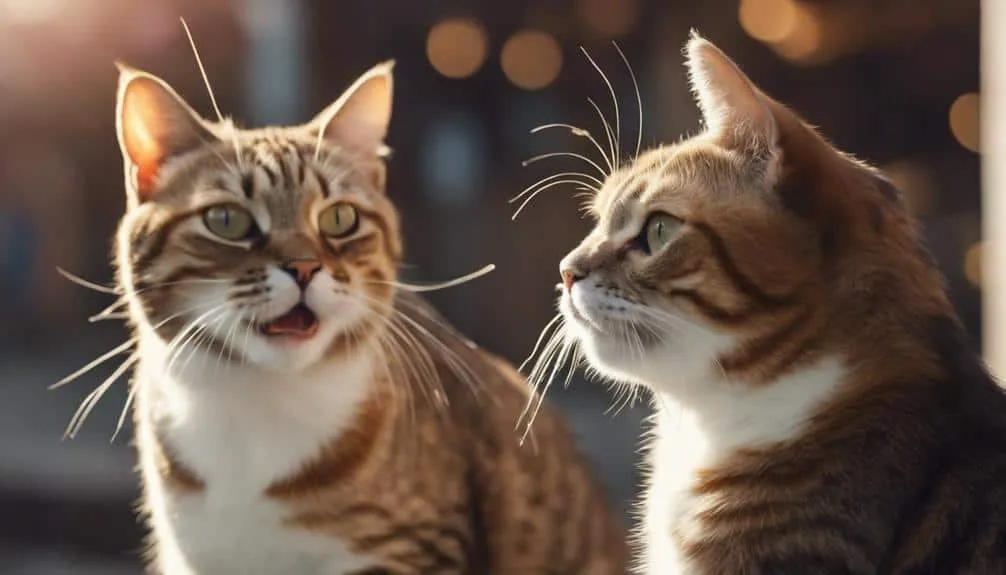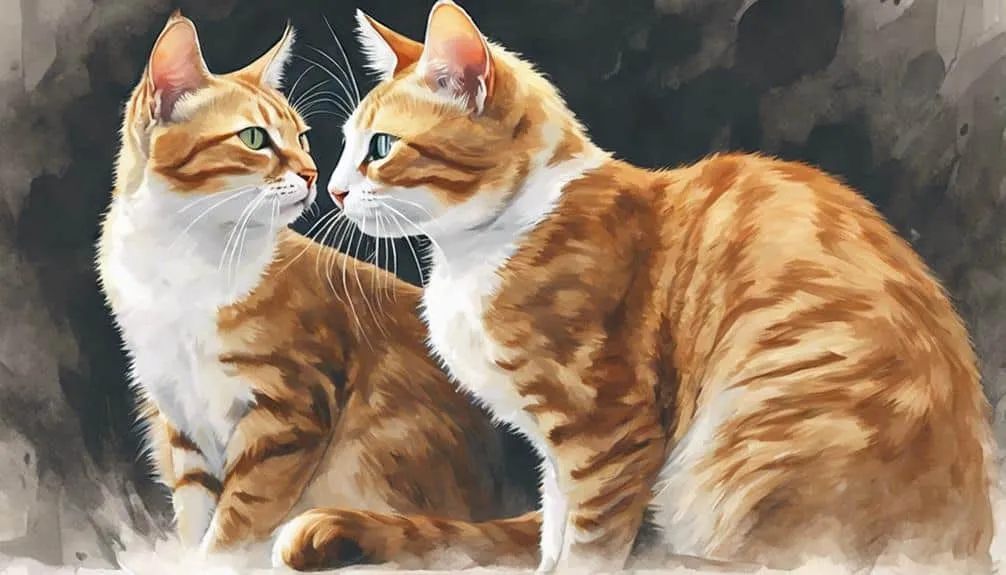The Best Fluffy Pancakes recipe you will fall in love with. Full of tips and tricks to help you make the best pancakes.

Cats make all sorts of sounds when they're mating, like screaming, purring, chirping, and growling. These sounds can vary depending on the cat and what stage of mating they're in. They're influenced by hormones and emotions, so it's important to pay attention to them.
By understanding these vocal cues, you can figure out if a cat is feeling comfortable, interested, or uncomfortable during mating. This knowledge helps create a good environment for the cats to mate in. Each sound they make gives insight into their interactions, showing whether they're being aggressive, curious, or uneasy.
It's crucial to recognize these vocalizations to ensure the cats' well-being while they're mating. Being able to interpret their sounds helps you respond appropriately to their needs and emotions during this important process.
Key Takeaways
When cats mate, they use various sounds like purring, chirping, growling, hissing, and even screaming to express their feelings. By paying attention to these vocalizations and their body language, we can better understand what they are trying to communicate. Female cats often make sounds and exhibit behaviors to show they are ready to mate, while male cats respond in their own unique ways.
The way cats vocalize during mating is influenced by hormonal changes, which can reveal information about their level of comfort, interest, or discomfort. By learning to decipher these vocal cues and behaviors, we can create a more relaxed and comfortable environment for the cats during mating. Understanding their communication helps us meet their needs and ensure a smoother mating process.
Vocalization Types During Cat Mating

When cats mate, they make different sounds to communicate with each other. These sounds can include screaming, purring, chirping, growling, and hissing. The type of vocalization and the pattern of these sounds can vary depending on the cat and the stage of mating.
These vocal cues are closely tied to hormonal changes and how the cats are feeling during the mating process. Cats use their vocalizations to show if they're comfortable, interested, or uncomfortable during mating. By understanding these sounds, we can get a better idea of how the cats are feeling and what they might need.
It's important to pay attention to these vocal cues and the behaviors that go along with them to make sure the cats are safe and well taken care of during mating.
Understanding Cat Vocal Cues
Cat sounds are super important when it comes to understanding how cats feel and what they want, especially when they're looking for a mate. To get what a cat is trying to say, you gotta watch how they act and move, not just listen to their meows and yowls.
When cats are in the mood for love, they might meow or yowl to show they're interested. But if they growl, that's a sign they're not feeling it. It's like their way of saying, 'Hey, back off!'
You can also tell a lot from a cat's body language. Pay attention to their tail, ears, and how they're standing. If their tail is up and their ears are forward, they're probably open to some kitty romance. But if their tail is low or their ears are back, they mightn't be in the mood.
Deciphering Cat's Mating Sounds

If you pay close attention to how cats communicate during mating, you can pick up on the subtle cues they give through their sounds and actions. Cats use a variety of vocalizations like screaming, purring, chirping, growling, and hissing to express themselves during mating. By observing these sounds along with their body language and movements, you can start to understand what they're trying to convey.
For example, a female cat may make specific sounds or exhibit certain behaviors to signal her readiness to mate. On the other hand, a male cat might respond with different vocalizations to show his interest and intentions. By decoding these signals and behaviors, you can get a better grasp of the mating dance between cats.
Understanding these communication patterns can help create a comfortable environment for the cats to mate successfully. So, next time you hear your feline friends making those interesting sounds, take a moment to observe their actions and see if you can decipher what they're trying to tell each other during this important process.
Significance of Cat Vocalizations
Cats use their vocalizations to communicate important information and emotions during mating. Hormonal responses play a big role in shaping these vocalizations, affecting how male and female cats behave. Male cats often meow or make sounds to attract females when they want to mate. On the other hand, female cats may use different vocal cues to show if they're ready for mating or if they're uncomfortable.
These meows and sounds act as signals that guide the mating interaction between cats. By understanding what these vocalizations mean, owners can better interpret their cats' needs and reactions during mating. Paying attention to the sounds and behaviors of cats can give valuable insights into how they interact during mating, making the experience safer and more harmonious for both cats.
Interpreting Cat Communication During Mating

When cats are mating, the sounds they make are really important for understanding how they're communicating with each other. Cats make all kinds of noises like purring, chirping, growling, hissing, and even screaming during this time. Each sound gives us clues about what's going on between the male and female cats.
For example, screaming is a common sound you might hear when cats are mating. This could be because of things like thorn-like spines or hormonal responses. Other noises might show aggression, interest, or discomfort. By listening to these vocalizations, we can start to figure out what the cats are trying to say to each other.
It's like a secret language that cats use to talk to each other during mating. By paying attention to both the sounds they make and their behaviors, we can better understand what our cats need. This helps us create a safe and cozy environment for them while they're going through this important process.
Frequently Asked Questions
Why Do Some Cats Become More Vocal During Mating?
When cats get chatty during mating, it just means they're really excited and have a lot to say. By making more noise, they're trying to communicate their feelings and needs better. Understanding these vocal cues is key to figuring out how they choose their mates and making sure they can reproduce successfully.
Do All Cats Vocalize During the Mating Process?
Not all cats make noise when they're mating. Some cats are actually pretty quiet during the whole process. It seems like each cat has its own way of acting when it comes to mating, and being silent is just one of those ways. By looking at how often cats vocalize during mating, we can learn more about how they communicate with each other and how they go about reproducing.
Can the Pitch of a Cat's Vocalization Indicate Something Specific During Mating?
When cats are mating, the pitch of their vocalizations can actually tell us a lot. Higher-pitched sounds might show that a cat is feeling urgent or trying to assert dominance. You'll notice other changes in their behavior too, like more aggression or restlessness, which go along with these different vocal tones. So, it's important to pay attention to these signals to make sure the mating process goes smoothly and safely.
Are There Specific Vocalizations That Indicate Successful Mating?
When cats are mating, it's not so much about specific vocalizations as it is about their behavior and body language. It's more about observing what the male cat is doing, like how he mounts the female, and seeing if the female is receptive to him. After they mate, you can tell if it was successful by watching how they interact with each other.
How Can Owners Differentiate Between Normal Mating Vocalizations and Distress Calls?
How can you tell the difference between your cat's normal mating sounds and distress calls? Well, paying attention to cues like body language, changes in frequency, and any aggressive behaviors can help you distinguish between typical mating vocalizations and signs of distress. Essentially, keep an eye on your cat's behavior for key indicators.
Conclusion
In simple terms, decoding the sounds that cats make when mating gives us valuable information about their behavior. By understanding the different noises cats use during this time, pet owners can better grasp their cats' feelings and needs.
The importance of cat vocalizations in mating is huge, as it's a key way for male and female cats to communicate. By paying attention and analyzing these sounds, cat owners can better understand how cats talk to each other during mating.










